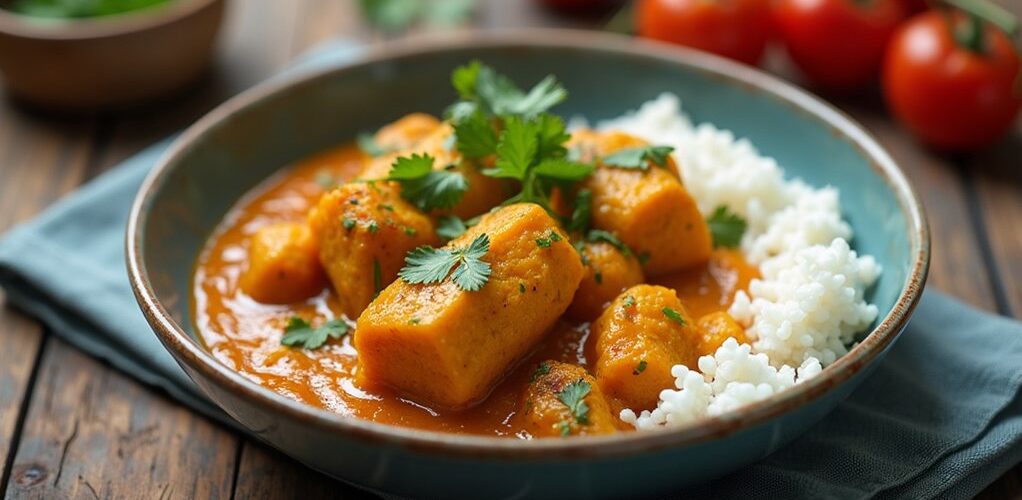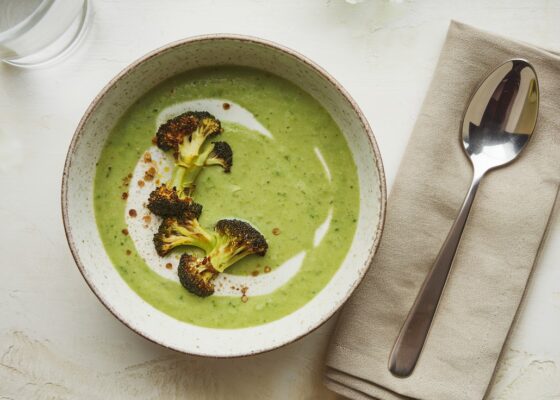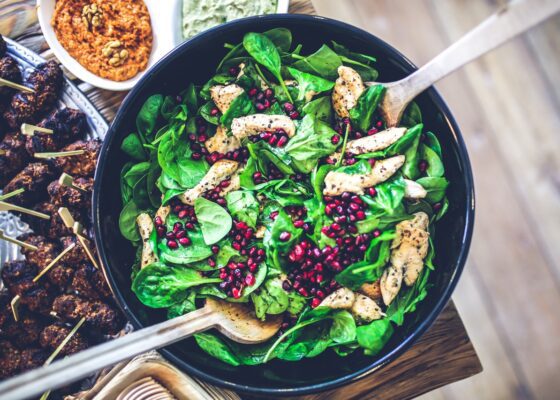
Traditional curry can be adapted for low-carb diets, containing as few as 5.7g net carbs per serving when properly prepared. Key modifications include using coconut milk instead of high-carb ingredients, incorporating non-starchy vegetables like bell peppers and spinach, and selecting lean proteins such as chicken breast or shrimp. Home-prepared curry pastes help avoid hidden sugars, while traditional spices like turmeric and cumin add robust flavor without significant carbs. Understanding specific ingredient choices reveals endless possibilities for flavorful, keto-friendly curry creations.
Key Takeaways
- Traditional curry recipes can be modified to be low-carb, containing as little as 5.7g net carbs per serving.
- Essential curry spices like turmeric, cumin, and garam masala contain minimal carbohydrates, making them ideal for low-carb diets.
- Using coconut milk and healthy fats creates rich, creamy curries while maintaining low carbohydrate content.
- Replace rice with cauliflower rice, shirataki noodles, or zucchini noodles to keep curry meals low in carbs.
- Choose non-starchy vegetables like bell peppers, spinach, and broccoli to add bulk without excessive carbohydrates.
Understanding Curry on a Low-Carb Diet
While curry is often associated with rice and starchy vegetables, adapting these flavorful dishes for a low-carb lifestyle is both achievable and rewarding.
Traditional curry recipes can be transformed into Keto Diet-friendly meals by making strategic ingredient substitutions and focusing on low-carb alternatives. A typical low carb curry can contain as few as 5.7g of net carbs per serving when properly prepared.
The key to creating satisfying low-carb curries lies in selecting appropriate ingredients and being mindful of hidden carbohydrates. Using coconut milk adds richness while maintaining low-carb status, and incorporating vegetables like bell peppers, spinach, and broccoli provides nutrients without excessive carbs. Including high-fat dairy like heavy cream can further enhance the flavor and satiety of your curry dish.
Home-prepared curry pastes are preferable to store-bought versions, which often contain added sugars and unnecessary carbohydrates.
Essential Ingredients for Keto-Friendly Curry
Creating a successful keto-friendly curry requires careful selection of specific ingredients that maintain authentic flavors while adhering to low-carb principles. The foundation of any keto curry sauce starts with healthy fats like coconut oil or ghee, which provide richness and help carry the complex flavors of traditional spices. For protein sources, skinless chicken breast, shrimp, or tofu serve as excellent low-carb options that keep the dish satisfying and nutritious. Vegetables like bell peppers, spinach, and zucchini add essential nutrients and bulk without compromising ketosis. When preparing the base, incorporating spices such as turmeric, cumin, and coriander guarantees authentic curry flavor while maintaining minimal carbohydrate content. Serving the curry over cauliflower rice or Shirataki noodles creates a complete, keto-compliant meal that satisfies cravings for traditional curry dishes. Additionally, olive oil is another excellent choice for a keto-friendly curry, as it promotes cardiovascular health and enhances absorption of fat-soluble vitamins, adding nutritional value to your dish.
Best Protein Choices for Low-Carb Curry
Selecting the right protein source forms the cornerstone of a successful low-carb curry, with each option bringing unique flavors and nutritional benefits to the dish. For ideal keto-friendly results, skinless chicken breast, shrimp, and tofu stand out as excellent lean proteins that maintain low carbohydrate content while delivering essential nutrients.
Lean proteins like chicken breast, shrimp, and tofu create the perfect foundation for keto-friendly curries while maximizing nutritional value.
These choices provide versatility and satisfy diverse dietary preferences without compromising taste.
Those seeking heartier options can incorporate cubed chicken thighs or lean beef cuts, which add richness while adhering to low-carb principles.
Vegetarians following a keto-friendly diet can opt for paneer or tempeh, both of which offer substantial protein content without excessive carbohydrates.
When selecting proteins, it's vital to choose unprocessed options without added sugars or high-carb ingredients to maintain the dish's low-carb integrity.
Additionally, incorporating non-starchy vegetables like bell peppers or spinach can enhance the nutritional profile and flavor of your curry, aligning with the ketogenic diet's emphasis on low-carb, healthy eating.
Selecting the Right Vegetables
The selection of appropriate vegetables forms the foundation of a successful low-carb curry, with options like bell peppers, broccoli, and spinach offering both nutritional value and minimal carbohydrates. These vegetables can be prepared through various methods, including quick stir-frying to maintain crispness, gentle simmering to infuse curry flavors, or adding leafy greens near the end of cooking to preserve their texture. Proper vegetable selection and cooking techniques guarantee the curry maintains its authentic taste while adhering to low-carb dietary requirements, with careful attention to cooking times preventing vegetables from becoming too soft or losing their nutritional benefits. Including non-starchy vegetables like spinach and kale helps maintain ketosis while providing essential nutrients.
Best Low-Carb Veggie Choices
When preparing a low-carb curry, smart vegetable selection becomes essential for maintaining both flavor and dietary goals. For a satisfying Keto curry recipe, low-carb vegetables like bell peppers, spinach, broccoli, and courgette provide bulk and nutrients while keeping carbohydrates minimal.
Cauliflower rice serves as an excellent base, offering a convincing alternative to traditional rice without compromising the curry experience.
To enhance both texture and taste while maintaining low-carb status, mushrooms and aubergine make excellent additions to curry dishes. Incorporating leafy greens such as kale or spinach not only boosts nutritional value but also adds vibrant color to the meal.
The combination of these vegetables creates a visually appealing dish that satisfies both dietary requirements and culinary preferences.
Cooking Methods For Vegetables
Proper vegetable preparation begins with mastering effective cooking techniques that preserve both nutritional value and flavor integrity in low-carb curry dishes.
When incorporating low-carb vegetables into curry recipes, sautéing and steaming emerge as ideal cooking methods that maintain their natural crispness while enhancing the overall dish's taste profile.
Sautéing vegetables like bell peppers and mushrooms allows them to develop a caramelized exterior while retaining their internal texture.
Steaming, particularly suitable for broccoli and cauliflower, helps preserve their nutritional content while ensuring they remain firm enough to hold curry sauce.
These techniques prevent vegetables from becoming waterlogged or mushy, allowing them to effectively absorb the curry's aromatic flavors while maintaining their structural integrity, resulting in a more satisfying dining experience.
Spice Blends and Their Carb Content
Understanding the carbohydrate content of curry spice blends proves essential for anyone following a low-carb diets. Traditional curry spices like turmeric, cumin, and garam masala contain minimal carbohydrates, making them excellent choices for maintaining flavor while restricting carb intake.
| Spice Type | Carbs per Tbsp | Best Uses |
|---|---|---|
| Garam Masala | 0.2g | Meat dishes |
| Turmeric | 0.3g | Rice, soups |
| Cumin | 0.1g | Vegetables |
| Curry Powder | 0.4g | Sauces |
| Store-bought Paste | 2-4g | Marinades |
While pure spice blends contribute negligible carbs to meals, store-bought curry pastes require careful consideration due to potential added sugars. Fresh herbs and aromatics like cilantro, ginger, and garlic enhance curry flavors while maintaining low-carb status, allowing for delicious and diet-compliant dishes. To further manage carb intake, consider using keto-friendly sweeteners like stevia or erythritol in recipes to maintain sweetness without disrupting ketosis.
Low-Carb Base Options for Curry
When preparing low-carb curry dishes, selecting and properly preparing the right base ingredients makes a significant difference in the final outcome. Cauliflower rice requires precise chopping and brief cooking times to maintain texture, while shirataki noodles need thorough rinsing and dry-frying to achieve the best consistency. Zucchini noodles benefit from quick cooking methods, such as light sautéing or brief steaming, to prevent them from becoming waterlogged while maintaining their structure and ability to hold curry sauce. Shirataki noodles are notable for their low carb content, making them an excellent choice for those following a keto diet.
Cauliflower Rice Best Practices
The selection of cauliflower rice as a base for curry dishes represents a game-changing solution for those seeking to reduce their carbohydrate intake while maintaining the satisfying experience of a traditional curry meal. With only 2 grams of net carbs per cup, this versatile alternative absorbs curry flavors effectively while supporting various dietary goals.
| Preparation Method | Benefits | Considerations |
|---|---|---|
| Home Processing | Fresh, customizable | Requires time, equipment |
| Pre-Made Options | Convenient, quick | Higher cost, limited shelf life |
| Golden Turmeric | Added flavor, color | May stain cooking utensils |
To maximize results, properly process cauliflower florets to achieve a consistent rice-like texture. Whether prepared at home or purchased pre-made, cauliflower rice serves as an excellent foundation for curry dishes while maintaining ketogenic and low-carb dietary requirements.
Shirataki Noodle Prep Tips
Since proper preparation techniques greatly influence the final quality of Shirataki noodles, mastering these methods guarantees a perfect curry-dining experience.
For best results with these keto-friendly noodles, begin by thoroughly rinsing them under cold water to eliminate any unwanted odors.
Next, boil the noodles for 2-3 minutes to achieve the desired chewy texture. These low-carb noodles contain only 5-10 calories per serving and effectively absorb curry flavors, making them an excellent alternative to traditional high-carb bases.
To maintain their distinctive texture while maximizing flavor absorption, add the Shirataki noodles during the final stages of curry preparation. This timing allows the noodles to soak up the rich sauce while preserving their structural integrity, resulting in a satisfying low-carb curry experience.
Zucchini Noodle Cooking Methods
Mastering zucchini noodle preparation techniques reveals a delicious, low-carb foundation for curry dishes that maintains authentic taste while reducing carbohydrate content considerably.
The process begins with transforming fresh zucchini into noodle-like strands using a spiralizer or julienne peeler. These low-carb alternatives contain only 3g of net carbs per cup, making them ideal for curry accompaniment.
Two primary cooking methods guarantee ideal results: a quick 3-5 minute sauté in olive oil or light steaming, both preserving the zoodles' texture and nutritional benefits. When selecting zucchini for noodles, choosing firm specimens is essential, as they maintain their structure better during cooking.
Proper preparation prevents mushiness, allowing the zucchini noodles to effectively absorb curry flavors while providing a satisfying textural element to the dish.
Healthy Fat Sources to Enhance Flavor
Incorporating healthy fats into low-carb curry dishes serves as a cornerstone for enhancing both flavor and nutritional value. Coconut cream and oil, along with ghee, provide essential fats that create a rich, keto-friendly base while improving the overall texture of curry dishes.
These healthy fat sources play multiple roles in curry preparation, from balancing intense spices to supporting the absorption of fat-soluble nutrients. Coconut oil's medium-chain triglycerides offer quick energy and potential metabolic benefits, making it particularly valuable for low-carb eating plans. Healthy fats like coconut oil and ghee also help reduce inflammation and promote heart health, as they are rich in monounsaturated and polyunsaturated fats. The combination of coconut milk or cream with other healthy fats not only enhances the dining experience through improved mouthfeel but also helps maintain satiety, an important factor for those following a ketogenic or low-carb lifestyle.
Common Curry Mistakes to Avoid
While healthy fats provide a solid foundation for low-carb curries, avoiding common pitfalls guarantees ideal results in both taste and nutrition. One significant mistake is choosing store-bought curry pastes without checking labels for hidden sugars and carbohydrates. Another error lies in incorporating starchy vegetables, which can quickly derail low-carb goals; instead, focusing on options like bell peppers and spinach maintains the dish's nutritional profile. Overcooking vegetables represents another common misstep, as it diminishes both nutrients and texture in low-carb curry dishes. Additionally, portion control often gets overlooked, leading to excessive carbohydrate intake even with seemingly appropriate ingredients. Using full-fat coconut milk instead of reduced-fat alternatives guarantees proper consistency while maintaining the desired macronutrient balance. It's crucial to avoid sugary foods and drinks that disrupt ketosis, ensuring that your curry remains low in carbs and keto-friendly.
Meal Planning and Portion Control
Successful low-carb curry preparation requires careful tracking of daily macronutrients, with special attention to carbohydrate content from vegetables, sauces, and accompanying sides. Measuring portion sizes before cooking helps maintain consistent carbohydrate intake across meals, while also ensuring adequate protein and healthy fat ratios. The balance between aromatic spices and carbohydrate-containing ingredients becomes easier to manage when meals are planned in advance, allowing for precise adjustments to meet dietary goals without sacrificing flavor. Incorporating low-carb alternatives like cauliflower instead of rice can enhance meal variety while keeping carbohydrate intake in check.
Track Your Daily Macros
Effective macro tracking forms the cornerstone of successful low-carb curry meal planning, allowing individuals to maintain precise control over their nutritional intake. By utilizing digital food tracking apps or traditional food journals, people can meticulously monitor their carbohydrate, protein, and fat consumption throughout the day.
Implementing proper portion control alongside macro tracking guarantees adherence to dietary goals while enjoying flavorful curry dishes. Regular monitoring helps identify patterns and make necessary adjustments to maintain ideal nutritional balance.
When preparing curry meals, incorporating low-carb alternatives like cauliflower rice can help stay within targeted macro ranges. Success in maintaining a low-carb lifestyle requires consistent evaluation of daily intake, making adjustments based on individual progress and health objectives, while guaranteeing meals remain satisfying and nutritionally complete.
Plan Portions Before Cooking
Precise portion planning serves as a fundamental step in creating successful low-carb curry dishes, allowing home cooks to maintain strict control over their nutritional intake.
Using a food scale to measure proteins and low-carb vegetables before cooking guarantees accurate macronutrient tracking while preventing overconsumption.
Pre-measuring ingredients, especially spices and proteins, allows for better portion control and helps maintain consistent carbohydrate levels across meals. Incorporating vegetables like bell peppers and spinach adds volume without markedly impacting carb counts.
For sustained success with low-carb curry preparation, implementing a systematic meal prep approach proves invaluable. By batch cooking and dividing meals into individual containers, home cooks can maintain precise portions throughout the week, making it easier to stay within their desired macronutrient targets.
Balance Spices With Carbs
Balancing spices with carbohydrate content requires careful attention to both flavor intensity and nutritional goals in low-carb curry preparation.
When creating a low-carb curry dish, select spices like turmeric, cumin, and coriander that deliver robust flavors without adding unnecessary carbohydrates. Careful monitoring of store-bought curry pastes helps maintain carb control while achieving desired taste profiles.
For ideal low-carb curry creation, consider these key elements:
- Measure spices precisely to maximize flavor without relying on high-carb sauce alternatives.
- Combine aromatic spices with fresh herbs to create depth without sweeteners.
- Layer vegetables strategically, starting with aromatics and adding leafy greens last.
This balanced approach guarantees a flavorful curry while maintaining strict carbohydrate limits, allowing for satisfying meals that align with low-carb dietary goals.
Quick and Easy Low-Carb Curry Recipes
Creating delicious low-carb curry dishes doesn't require hours in the kitchen or complex preparation methods. A simple Coconut Chicken Curry can be prepared by combining lean chicken pieces with coconut milk, aromatic spices, and low-carb vegetables for an easy keto-friendly meal that's both nutritious and satisfying. Home cooks can experiment with various protein options while incorporating cauliflower rice or shirataki noodles as grain alternatives. Quick-cooking vegetables like bell peppers, spinach, and mushrooms not only reduce preparation time but also add essential nutrients while keeping carbohydrates in check. The natural properties of curry spices, including turmeric and cumin, provide robust flavoring without adding unnecessary carbs, making it possible to create flavorful curries that align with low-carb dietary goals in minimal time. Vegetarians can enjoy a diverse diet by substituting chicken with tofu or tempeh to maintain the balance of healthy fats and plant-based proteins.
Storage and Batch Cooking Tips
The convenience of low-carb curry recipes extends beyond their quick preparation time to their excellent storage potential. Through proper batch cooking and storage techniques, these flavorful dishes can maintain their quality for several days in the refrigerator or up to three months in the freezer when stored in airtight containers.
For ideal batch cooking success:
- Remove high-carb vegetables like bell peppers before freezing to maintain the dish's low-carb profile.
- Label containers with freezing dates and seal them tightly to prevent freezer burn.
- Store individual portions separately for better portion control and easier carb tracking.
When reheating curry dishes, whether from the refrigerator or freezer, guarantee thorough warming to enhance the melded flavors that develop over time, making each serving as delicious as the first.
Restaurant Guide for Low-Carb Curry Options
Steering through restaurant menus for low-carb curry options requires strategic ordering and knowledge of common ingredients, particularly since traditional curry dishes often come paired with rice, naan, or other high-carb accompaniments.
Diners can maintain their low-carb lifestyle by requesting specific modifications, such as substituting cauliflower rice for regular rice or skipping the naan altogether.
Southeast Asian options, particularly Thai curry dishes made with coconut milk, naturally align with low-carb requirements.
When ordering Indian curries, focus on protein-rich options like chicken tikka, shrimp curry, or paneer dishes, while requesting sauce modifications to avoid hidden sugars and starches.
Enhance the meal by selecting complimentary low-carb sides such as cucumber salad or sautéed vegetables, ensuring an authentic curry experience without compromising dietary goals.
Measuring Success: Tracking Carbs in Curry
Successfully tracking carbohydrates in curry dishes requires careful attention to ingredient measurements and portion control.
When monitoring net carbs per serving, it's essential to account for hidden carbohydrates in sauces, condiments, and curry pastes. Making it a meal while maintaining low-carb status involves selecting appropriate side dishes and tracking total carbohydrate content.
- Record the carbohydrate content of each ingredient, including spices, vegetables, and proteins
- Measure portions accurately using kitchen scales or standard measuring tools
- Calculate net carbs by subtracting fiber content from total carbohydrates
Frequently Asked Questions
Can I Eat Curry on a Low Carb Diet?
Curry can fit into a low carb diet when selecting appropriate ingredients and low carb alternatives. Meal preparation should focus on protein-rich bases, avoiding starchy components while maintaining traditional spices.
Is Spicy Food Good for Low Carb Diet?
Spicy food provides significant benefits for low carb diets through natural metabolism boost and hunger suppression effects. These properties help maintain weight loss goals while adding flavor without increasing carbohydrate intake.
What Spices Are Good for Low Carb Diet?
Curry spices like turmeric, cumin, coriander, ginger, and garlic offer significant low carb benefits while providing flavor enhancement. Other suitable options include chili powder, garam masala, and fresh herbs.
Are Curry Dishes Keto Friendly?
Curry dishes can be keto-friendly through careful ingredients analysis. Traditional recipes require low-carb variations, substituting high-carb components with keto-friendly alternatives like cauliflower, coconut milk, and lean proteins.
Conclusion
Curry can indeed be a delicious low-carb option when prepared thoughtfully. By choosing the right ingredients, monitoring portions, and understanding spice combinations, anyone following a low-carb diet can enjoy this flavorful dish. Whether cooking at home or dining out, focusing on protein-rich ingredients, low-carb vegetables, and authentic spice blends allows curry to remain a satisfying meal choice while maintaining ketogenic or low-carb dietary goals.










No Comments